
Meat (beef), starch (fresh rice noodles), greens (chinese brocoli), eggs and onions (the essentials for many) and the seasonings: All ingredients for Phad See-ew Thai Noodles!
When I went to Wing’s, they gave me a variety of products to play around with. One was their fresh rice noodles, made with rice they grind themselves. I decided to make Phad Sew- Asian comfort food- starch (rice noodles), meat (beef) and greens (Chinese brocoli) and fried egg (essential to complete any meal!) all cooked together in a wok- with some soya sauce and onions for good measure! Here’s how to make it; it’s easy peasy!
You need:
300g of fresh rice noodles
300g of chinese brocoli, cut into 2 inch lengths
2 sliced onions
200g of beef, like faux filet, in 1 1/2 inch strips
2 tbsp of dark soya sauce mixed with a bit of brown sugar
1 tbsp of tamari
1 tbsp of fish sauce
oil
2 eggs, beaten
pepper (mix of white, black and Szechuan in my case)
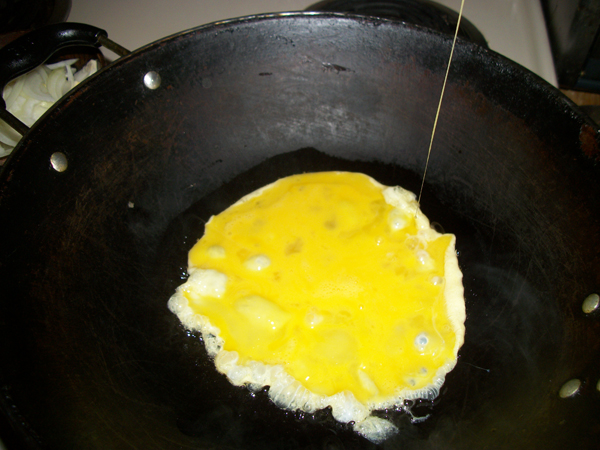
Cook the beaten egg in oil over high heat. Turn it once, take it out and set aside.
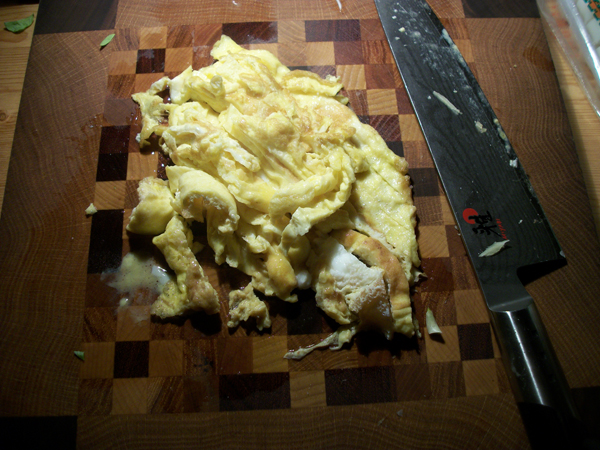
Chop your eggs into strips
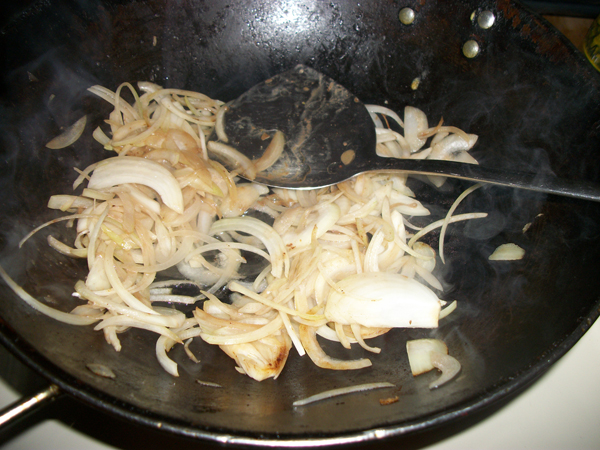
Sauté onions and then set aside
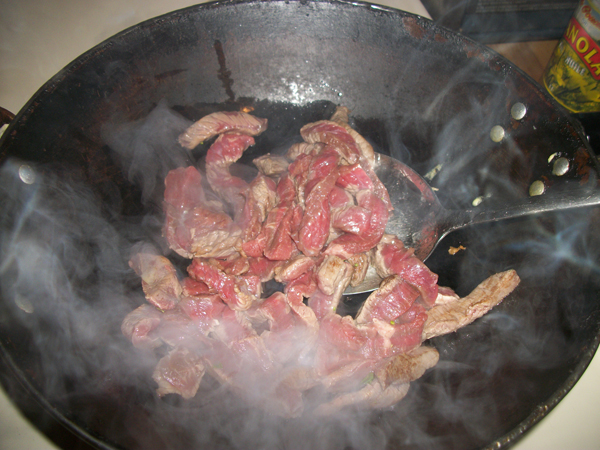
Seize your beef strips over high heat and then set aside
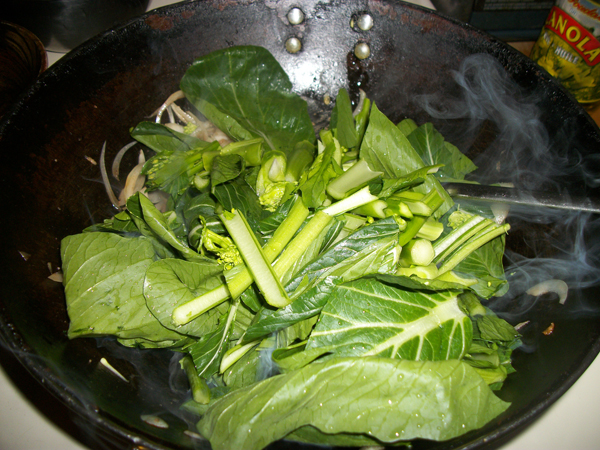
Sauté your chinese brocoli quickly because you don't want it to get overcooked (30 seconds)
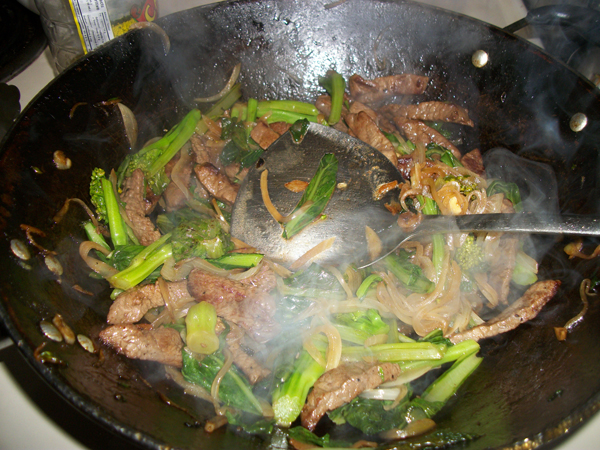
Put the beef, brocoli and onions back together in the wok.

Put the noodles in boiling water just long enough to separate them and then put them in the wok with the other ingredients. Work fast! You don't want your noodles or brocoli to overcook as mine did while I was trying to get nice photos!
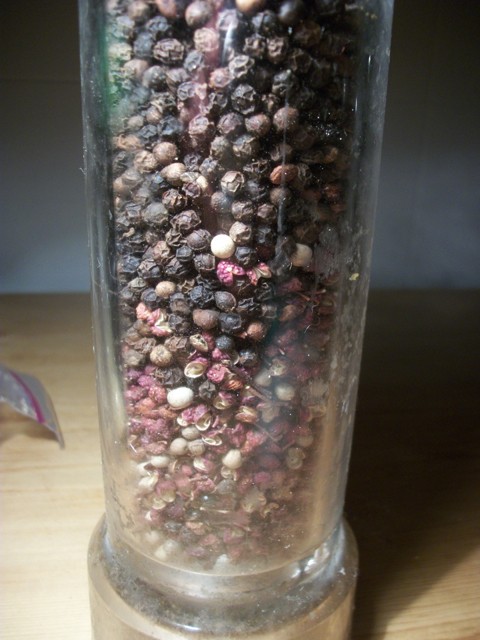
Season your Phad See-ew with fish sauce, pepper and soya sauce
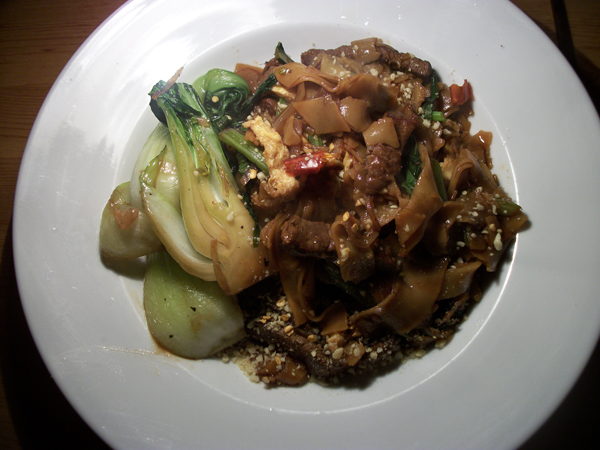
Here it is with some peanuts, hot peppers and stir-fried baby bok choy (more greens for me!)
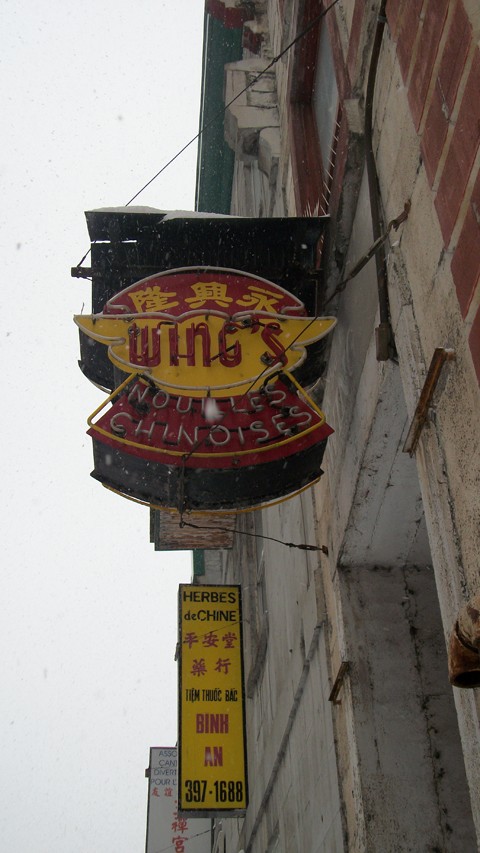
Wing's Sign- Timeless Chinatown
I went to visit Wing Noodles on the corner of Côté and de la Gauchetière in Chinatown. The machinery was fantastic and I really felt I was in Willy Wong-ka’s factory of magic. I could not photograph the machines, as they did the trickiest parts of the tasks: mixing, rolling and cutting dough. They also steamed, baked, fried and cooked. The pump-it-out-o-matic machines work tirelessly, some even with no one next to them monitoring production. It’s as if the factory has a life and rhythm of its own. Little crêpes piped onto a gas oven conveyor belt, are folded while soft, stuffed with a fortune by the machine and sent down into a bin to cool and harden with their proverbial compadres. One far out machine also had a series of six blades that guillotine noodles to standard size one after the other.
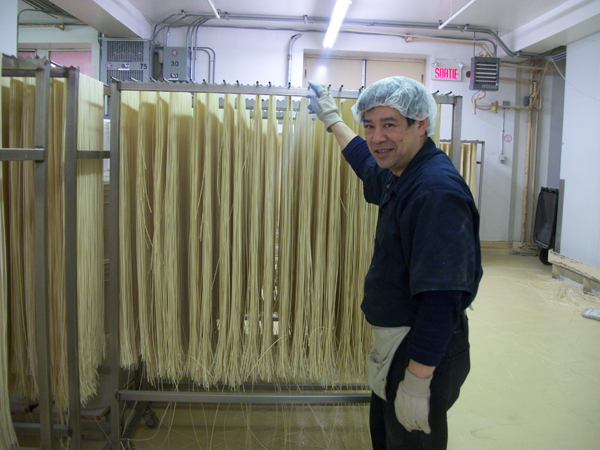
Owner George Lee with noodles being dried and cut
The employees were as cheery as oompa loompa’s whether in delivery, packaging, labelling, measuring into the mixers or in other jobs and departments. There is a real feeling of being part of something magical at Wing’s, and part of a family. The workers are a mix of all nationalities and the owners George and Gilbert work on the floor doing production and then move into offices, over onto the phones, etc. They were present on all levels. Workers help each other and get their foot in the door with common sense, work ethic and punctuality. Most are able to perform two or three different production tasks: to keep them sane and afford Wing’s the versatility of changing production on a dime.
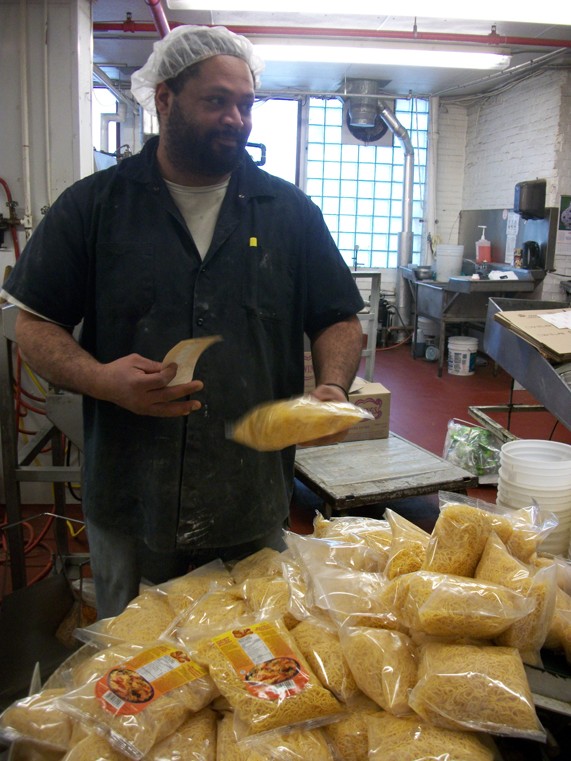
Jeremy Charles- Excellent cook, conaisseur and Martial Artist, the most versatle production employee- and my friend
Wing’s makes everything from Wonton wrappers, egg roll wrappers, pot sticker wrappers, gyoza wrappers, soya sauce, plum sauce, white vinegar packages, almond cookies, fortune cookies, a plethora of noodles including fresh rice noodles made with rice they grind themselves, and a collection of organic noodles. They started making organic noodles about ten years ago and sales are stable, but never took off. Fresh noodle production has been lowered as restaurants are tightening their belts and opting for the cheaper dried noodles with the recession.
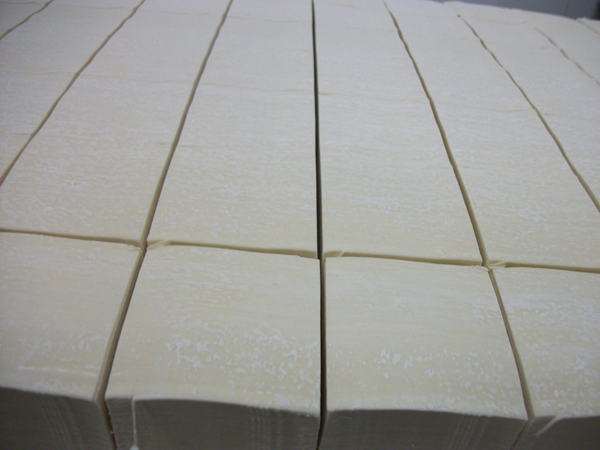
Wonton Wrappers fresh out of the machine
Wing’s fortune cookies are bilingual and they do not include lucky lottery numbers as they do not condone gambling. They made their first batch of cookies specially for a Jewish man that wanted to propose to his wife by having the ring inside in the 60’s. They then decided to start producing them on a large-scale.
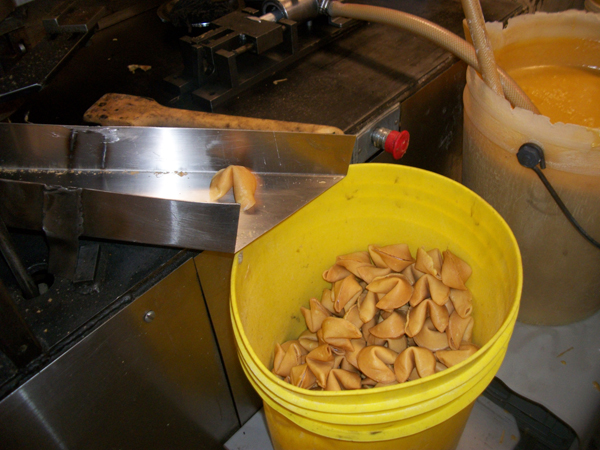
Here comes the fortune cookie out of the machine, still a little warm and soft- The last fortune I got was: "Each moment should be treasured."
Why am I telling you this? Do you care about the industrial production of Chinese food products in Montreal? Maybe you do, or maybe you don’t, but Wing’s itself is important because it is the last-standing original business in Chinatown. Owner George’s Great Grand Father came over to Canada in 1880. It seems he came to work on the last bit of railroad construction. After that, he opened a laundry in St-Jean. This was the typical Chinese trade as it required little language proficiency or start-up costs. His son H.C. Lee worked with him. H.C. started his own laundry/grocery service in Montreal with a cart around the turn of the century, then moved back to China and married there.He came back to Montreal in 1911 and started an import/export service. He and his wife had 6 sons, three of which were university educated. Wing’s as an actual producer of noodles started in the 40’s during the war when noodles could not be imported because of Japanese occupation of China and it was incorporated in 1953. It was taken over by four of H.C.’s sons in the 40’s. The most well-known to the public was philanthropist Arthur Lee.
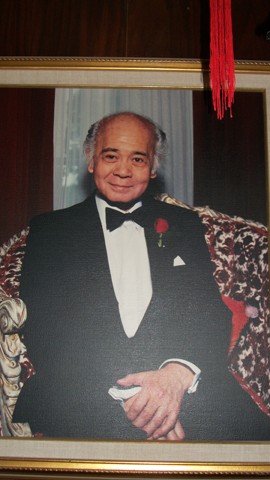
The Portrait of Arthur Lee up in the Office: philanthropist, Businessman and Family Man
The four brothers used their expertise in chemical, mechanical and electrical engineering to come up with or modify existing equipment for noodle and cookie production and refrigeration. (They still have and use the original fridge.) Wing’s already existed under their father, but they brought it up to the level of mass-production. Production has been pondered and tightened on every level.Arthur Lee’s son Gilbert is owner of Wing’s along with his cousin George. George, like his father, prefers to be in the back doing production. The sons of the other brothers opened up their own plants in Toronto and Edmonton. The Wing’s in Toronto is the size of a football field and is the most profitable since most distribution now takes place in Toronto.
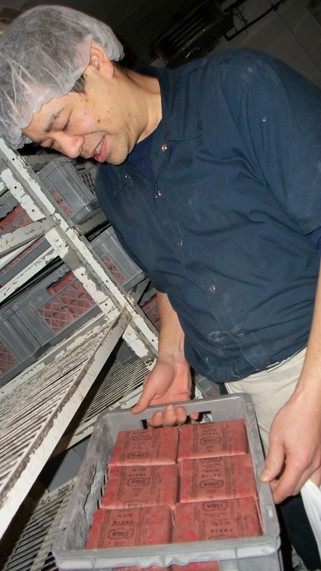
George- Owner and 4th Generation Chinese Canadian and 3rd generation Wing's
Wing’s in Montreal has had to adapt to heavier regulation over time. George says that it would be impossible to start a business the magnitude of Wing’s today with hard-work; the heavy regulation and the city’s outrageous taxes limits opportunities to big investors. George feels for the little guys starting-out because of all of the financial and regulatory obstacles they face. In fact, George says that running a business like Wing’s is a huge endeavour for the profit it generates, but because it is the last-standing original business in Chinatown and they are holding on. They have become a pillar in the Chinese community and they feel they have a social responsibility. Most importantly, they believe in Wing’s.

Wing's- Original Pillar of Chinatown
George walked me through the areas of production and explained the outdoor silos of flour that had programmed amounts of sucked out of them through pipes and sent to the appropriate area. He explained how each product was made, but even more than that he walked me through Chinatown in November to paint a picture of Chinatown in the 70’s when he was a teenager and young adult. Chinatown is now in a great location, but historically it was basically squeezed by the Red Light district to the East and North and the homeless quarter to the South and was the slum where the Chinese were confined. He described the restaurant Ho Ho’s on the South Side of de la Gauchetière between Clark and St-Urbain where you could get Chinese stew, a butter bun and the best Boston Cream Pie for $3.25. People ate along a counter looking out on the street and men mostly did lady-watching. Upstairs was clandestine gambling joints as gambling was even bigger in Chinatown then than now! People lost businesses through gambling. On the east side of St-Laurent were many prostitutes, massage parlours and occasionally people engaging in the transaction of sex for money in the street. The west side was full of Asian variety stores and on the southwest corner of St-Laurent and Réné-Levesque was a cinema where you could see three Kung Fu movies for $3- 6 hours of Kung Fu! St-Laurent and de la Gauchetière was also the home of the Rodeo strip club- pronounced “Lodeo”. Cheap food, gambling, strippers, kung fu cinema- Chinatown’s definitely quieted-down!
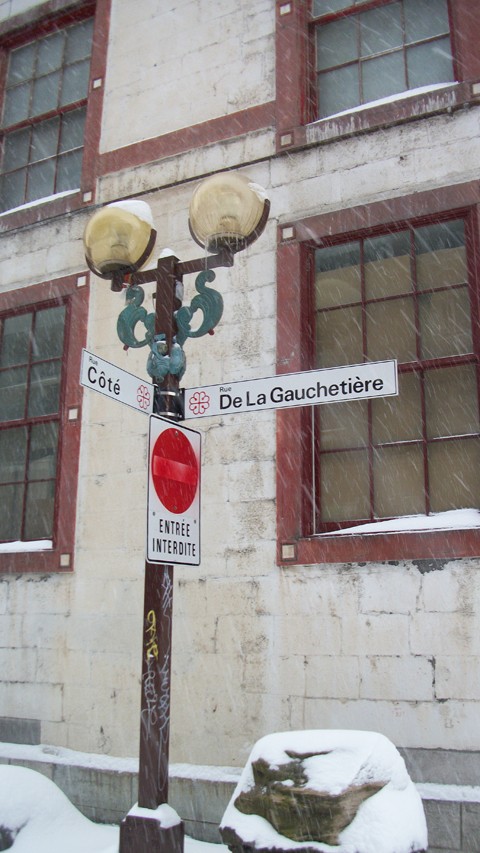
Chinese Streetlamp in the Snow in Montreal
George’s Aunts and Uncles lived in Chinatown and he said there was a real “vie de quartier” or neighbourhood life. People depended on each other and the community was close-knit. The Chinese community had close ties with the Jewish community based on business and the Jewish love of Chinese food. Wing’s helped the huge Wong Wing’s get going as did the owner of Steinburger’s with business advice and encouragement. People moved out through the 70’s and 80’s and the city’s policies and corruption continued to ravage Chinatown until many businesses closed. George says that Chinatown is now a collection of new and disconnected immigrants that only care about making a buck.
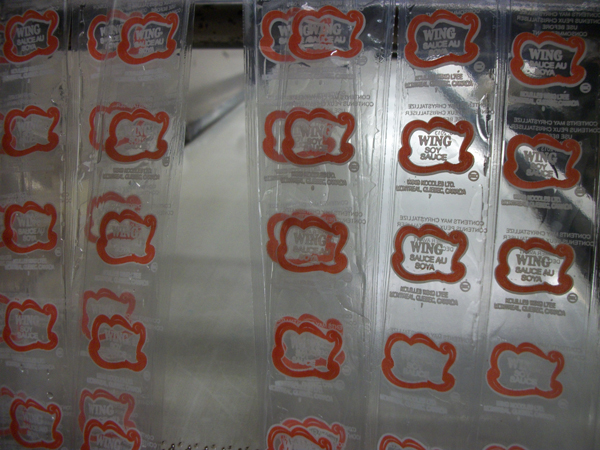
Individual packages waiting to be filled with sauce or vinegar
George recognizes that Wing’s did so well because of the openness and curiosity of the Québecois. It was also built on the many contributions of workers at Wing’s from the Caribbean, Panamanian, Arabs, Greeks and many more. Their first non-Chinese employee from outside of the family, hired in 1961, was a Greek man who worked there for 40 years. George said the hardest phone call he ever made was to call him to tell him that his father Mr Lee had died. This was crazy because he had started out as a grumpy worker and they all called him “Kweilo” or “White Devil”, but he became an integral member of the family over the years.
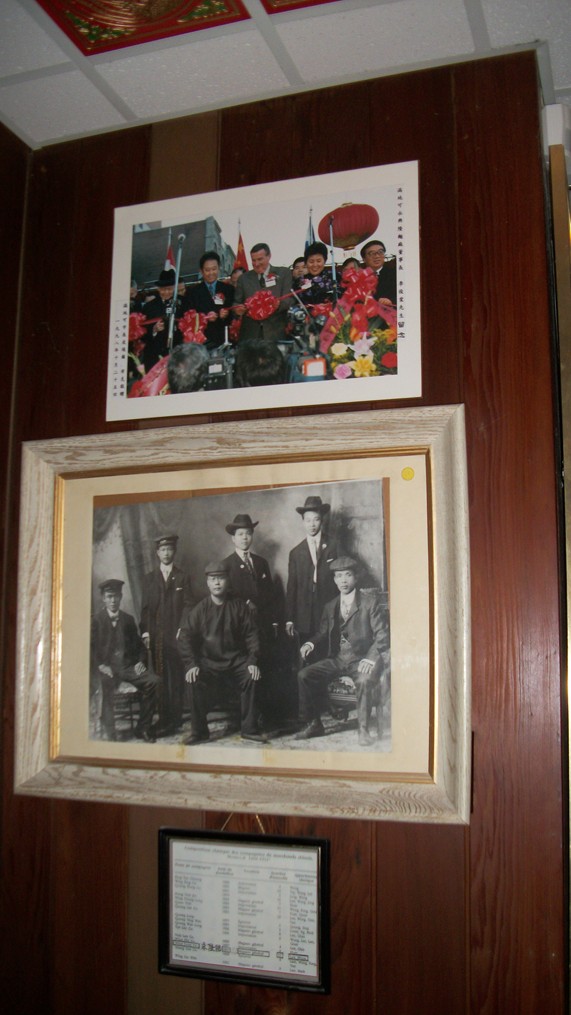
Some of the history on display including family photos with the four Lee sons (and a fifth), and records of Wing's as an importation business
Wing’s is a fantastic mix of technology, secrets, story, family, hard-work, close-ties, innovation, tradition and diversity within Chinese Montreal. Wing’s exemplifies the legacy of a family through the events and tribulations of time. It is a pillar in Chinatown but also a talisman for the entrepreneur, the immigrant, the family, the funky factory and the Montrealer.
Go Check out: Wing’s ad from 1970!
One more intersting thing: for customized fortune cookies for big events please see www.biscuits-fortune-chinois.ca Denis Bordeleau has been making customized fortune cookies with Wing’s help for 20 years! I met him on Fitz & Follwell’s Flavours of the Main tour of which Wing’s is a destination.
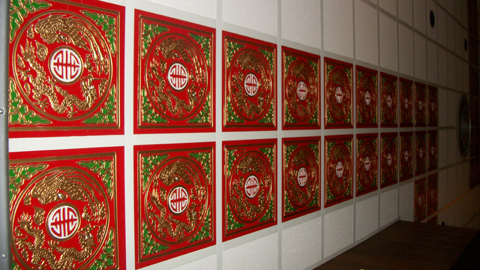
Chinese tiles on the ceiling at Wing's

Letting the child in you out of the bounds of convention is the key to creation and true passion.
For most people, the key to unblocking creativity is to get your inner child to feel safe enough to come out and play. The creative child needs to know that she will not be chastised because her creation is not organized, presentable or adult enough.
Lately I’ve been encountering some blasts from the past that reminded me of what drew me to food and cooking in the first place. The first was this plastic play kitchen that I saw taken out to the curb with the trash. It was sitting abandoned in the rain in Mile End with in its mid 80’s My Little Pony colours. I didn’t actually have one of these, I would actually cook in the real kitchen, but they seemed like the promise of something really great. Like those Magic Ovens where you mix the powder with liquid, put it in the oven and cake comes out. Amazing! I had a magic trick set as a child, but I didn’t get as into it as I did experimenting with food.

The abandoned play stove. Come on, revive it in your adult life.
I also saw an automated kitchen from the 70’s at a Museum in Germany this summer. It was the promise of all of the magic of the kitchen for adults. You don’t have to be the mad scientist in the laboratory, the kitchen can do everything itself…and you get all the credit! It turns out that automated kitchens never took off. People didn’t want to be cut out of the equation. They wanted to do the work. Samsung has come back with a bigger and badder automated kitchen that tells you what to do, keeping you in the process it plans and facilitates and you execute and confirm. It will order all of the food from the grocery store with your okay and guide you through the process. The automated and play kitchen evoke the promise of miracles and something magic happening. The kid’s kitchen is creative, but the automated kitchen is the adult creativity killer.
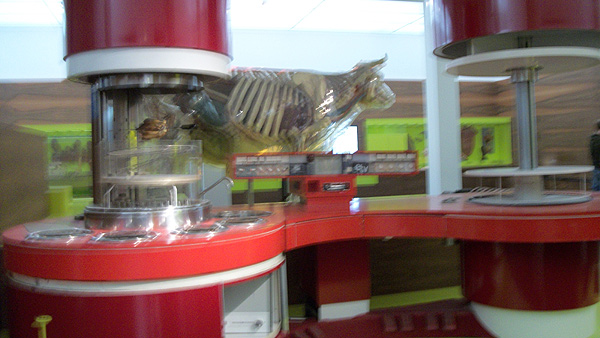
Sorry it's blurry, but I wasn't allowed to take this photo. The 1970's Automated Kitchen: promising you don't have to be creative or make mistakes, the machine does it all for you!
This Christmas, as I made curry powder and paste for my loved ones, I remembered that I have been cooking Christmas presents since I was 9 years-old. I baked shortbread cookies and decorated them in secret when my mom would be gone curling. I would vacuum-pack them and I had my my secret spot in the deep-freezer. I produced a different baked good each week for 3 or 4 weeks and gave a bag of frozen baked goods to each of my Aunts. I did this for a few years. I guess I followed the example of my Mom who made little jars of Roasted Garlic Dijon to put in stockings and my Auntie Janet, who made jalapeno jelly (Red and Green), but I did what I wanted to do on my own! I was so proud when I would give the bag of frozen cookies to my Aunt’s. Frozen cookies were accompanied by a variety of arts and crafts and brought them in a box that I declared top secret and off-limits. My Mom would say to the people in the family with puzzled eyes and a creased forehead, “I don’t know. I didn’t help her. She did it all on her own.” I like the kitchen best when it feels like arts and crafts made for the ones you love.
I also did a food collage in September with images from Sel et Poivre and Saveurs culinary magazines from the 1980’s. At first, flipping through I thought, “boy this is dated”. But the more I looked, the more I felt these deep heart pangs of nostalgia. I started devouring cookbooks when I was about 5 years-old. That was in 1987. The images in Sel et Poivre were of what seemed the ultimate culinary ideal at the time (some kind of 80’s glamour with the French still holding the podium.) Saveurs explored world cuisine, and me being from the West Coast I grew-up with Japanese, South East Asian and Indian cuisine being more my traditions than North American stuff. They say that in food there is a constant tension between the familiar (what we ate in our early childhood) and novelty (discovering food). Our personality and mood tends to position us on the spectrum daily- when lonely or sad we crave the familiar when joyful and exuberant the novel. My familiar was very novel to others and my personality and mood constantly pushed me to try new things.
I started cutting and pasting my collage furiously. I mapped out my gastronomic timeline. My love of garlic, fish, seafood and spices was imprinted in my pre-embryotic soul, being represented at the bottom of the long ascending imagescape. My mom (represented as a barbie in a vintage knit dress) showed me soufflés, clams and poached eggs. There was a breakfast-in-bed tray to remind me of the farm breakfasts served to me on a tray at my Grandma Jean’s: Farm eggs, fresh thick farm bacon, tomato slices from the garden, cottage cheese, buttered toast and chicken-in-the-mug (chicken bouillon).
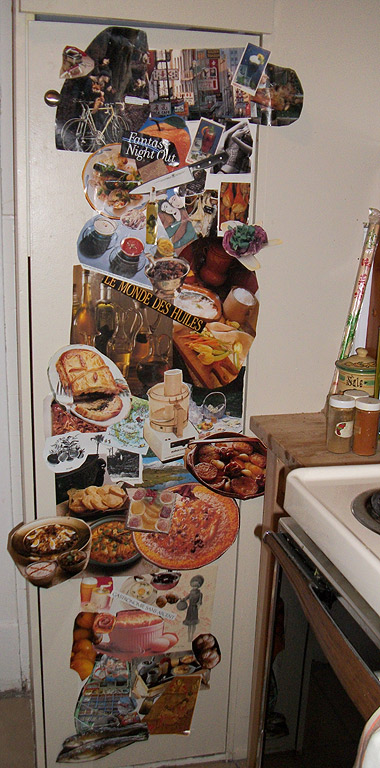
Here is the true culinary influences in my life: some cultural, some people, some innate...No justification, this is where I come from!
Then there was Indian bread, rice and curry photos, as when I was 6 years-old I started getting baby-sat by an Indian family and I ate Indian food every day for a few years.

Here is my familiar: apricots (from B.C. fruit stands), garlic, clams, mom, poached eggs and home-made ice cream.
Later came Coulibiac, one of the first dishes I ever made at Nuart. Herbs and perfumed oils are represented. There is Spanish Garlic soup which I made regularly and then saw again when I worked at Casa Tapas in another form. I also went to Spain and worked briefly at El Centro Gallego and so put a leg of Serrano in for good measure. I weaved in the Korean barbecue apparatus, Chinese, Italian and Japanese fair and scenery, and I put in other symbols of the people and events that had deep affective ties to certain foods and periods in my life.
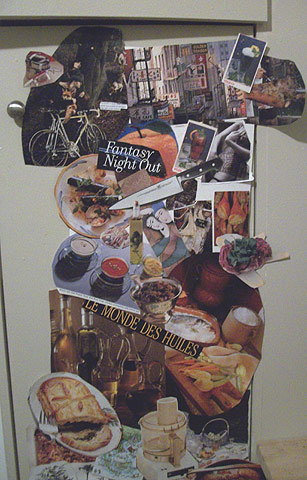
This is the end of the last period of my life, there was a clash of influences and currents and hiding from the world was no longer possible. There was sex, rivalry, booze and the split. My food relationships had to be redefined. I had to eat alone for awhile....digest.
This exercise was fun and liberating. It made me remember where I came from, and how important food was in my ties with the people I am closest to. It also reminded me that my culinary journey has been very rich and varied. I am also very proud of my gastro/culinary roots. The path I’ve tasted or cooked in my life is my own. No one can disqualify it. It is unique- and so is everyone else’s. Our past is not dated or flawed it is a series of pieces in our evolution.
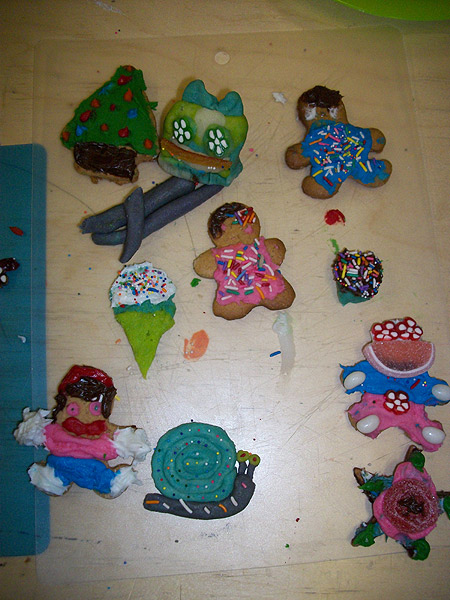
Here are some wonderfully decorated cookies from kids that I gave a workshop too. Everyone had fun and all pieces were original and spontaneous.
Four tips to keep the love and creativity in the kitchen:
-
Remember that kitchens are places of magic, creation and transformation. They are safe for anyone to come and play in- especially the creative inner child.
-
Food is only as fun and exciting as the people you share it with. It is a gift.
-
Remember where you came from and what you instinctively loved to cook, smell and look at. Those are your roots and tools and they are in you to inspire you. You do not taste things like anyone else and you do not even taste the same thing the same way from moment to moment, so do not try to be anyone else. Just be who you are naturally and instinctively now.
-
Challenge yourself. Cooking shouldn’t be intimidating. Try things out. You’d be surprised what seems daunting, but is actually very simple. You’ll also be surprised how crafty you can be at saving or adapting something. If it is a flop, that’s experience under your belt. Own your mistakes and your inspiration!
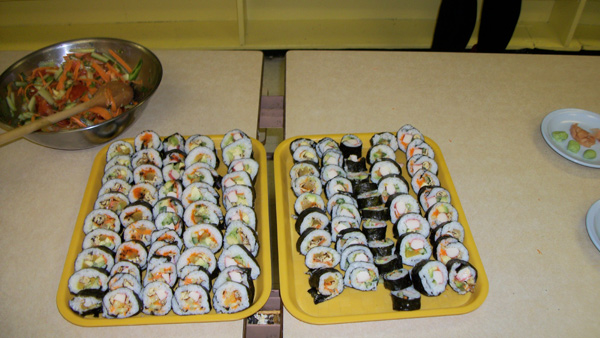
Beautiful Sushi made by first-timers during family cooking workshops at Riverview Elementary School. Yet again, beautiful and unique!
CATEGORIES
Archives
- February 2022 (1)
- October 2020 (2)
- September 2020 (1)
- January 2016 (1)
- January 2015 (1)
- October 2014 (1)
- February 2014 (1)
- January 2014 (1)
- July 2013 (1)
- June 2013 (2)
- May 2013 (1)
- March 2013 (1)
- February 2013 (2)
- November 2012 (1)
- September 2012 (1)
- June 2012 (2)
- May 2012 (1)
- April 2012 (1)
- March 2012 (1)
- February 2012 (1)
- January 2012 (2)
- December 2011 (1)
- November 2011 (4)
- October 2011 (4)
Popular Tags
'Round Table Tours Asian breakfast business prolfiles cabbage canning Community Europe Events farms fermentation Fitz & Follwell Food & Story Food history Food Production food tours fresh juices Friends gastronomy health herbs History Italy kimchi Meal exchange Nuart organic preserves public Quebec restaurant Rumble & Shakes Réseau d`Entraide de Verdun salt smoothies spicy Tours de la Table Vegan youtube videos

